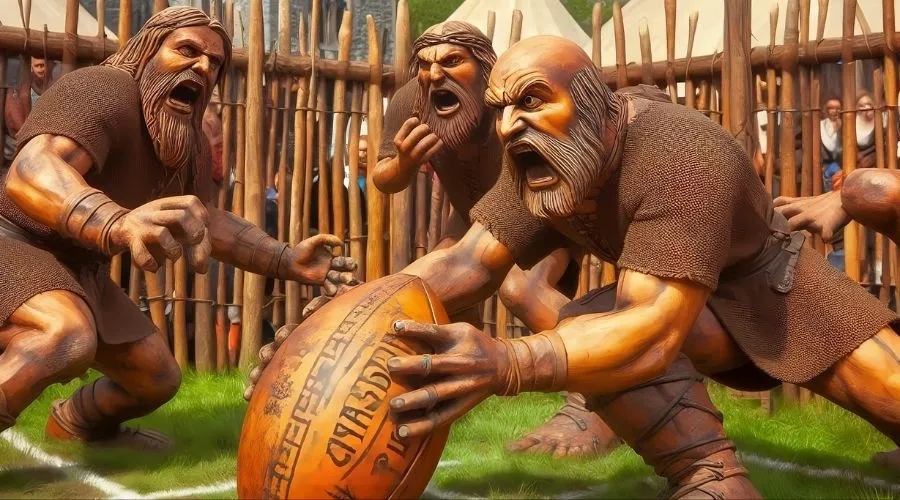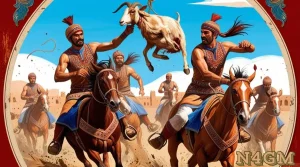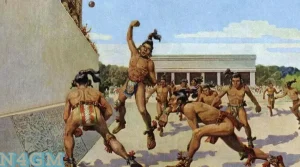Growing up in this era, I heard stories of the ancient game of Cnapan that was once played in the Middle Ages. It is a fascinating relic of medieval Welsh culture. It seems to have slipped through the cracks of history. As I learned more about this sport, it fascinated me.
I realized it was similar to modern rugby. It may have even influenced its development. Let me take you back in time and share what I know about this medieval Welsh game – its rules, gameplay, origins, etc.
The Medieval Welsh Game
Cnapan (Medieval Welsh Game), or Criapan, is a Welsh ball game from medieval times. It was popular in western Wales, especially in Carmarthenshire, Ceredigion, and Pembrokeshire.
The game began in the Dark Ages. It involved large groups of players from neighboring villages. They fiercely competed to transport a wooden ball to their village church’s porch.
It was often compared to early football and rugby. This was known for its chaotic, physical nature. It blended both sports with a uniquely Welsh twist. The game was a social event and a brutal contest. It had a community pride but a violent edge, reflecting medieval life.
Rules & Gameplay
Players & Setup:
- Played between large numbers of people from two neighboring parishes.
- No written rules were found, but players were familiar with how the game was played.
The Ball:
- The ball was solid wood, slightly larger than a cricket ball.
- Before the game, the ball was soaked or boiled for at least 12 hours in oil, animal fat, or another lubricant.
- This process made the ball slippery, difficult to hold, and unpredictable during play.
Objective:
- The goal was to get the ball to the church porch of your own village (called a commote).
- There were no fixed borders or goal lines. The area between the two villages was the playing field.
Gameplay:
- The game would last until the ball reached a team’s church or it became dark.
- If no side scored by sunset, the match ended in a draw.
- Players advance the ball by kicking, carrying, or hitting it.
- Unlike modern football or rugby, there were few formal rules about how the ball could be handled or moved.
Duration & Intensity:
- The game was played continuously with no breaks until a goal was scored or darkness fell.
- It was a brutal, intense game. It reflected the ruggedness of medieval life.
The Violent History
Historical Roots
- The game has been popular in Wales since at least the Dark Ages. Some historians suggest it may date back to antiquity.
- It served as a means for youth to stay active and avoid idleness during peacetime.
Account by George Owen of Henllys (1603)
- In 1603, Welsh historian George Owen provided a detailed description of Cnapan.
- Owen claimed the game was “thought to be of great antiquity.”
- He emphasized that the game was intended to “exercise their youth in a time of peace and to avoid idleness.”
High Risk of Injury
- This was brutal. Injuries were common in the game.
- The game’s intense contact and chaotic play made it very dangerous.
Impact on Property
- The game was so violent that “careful householders had to protect their windows with hurdles and bushes.”
- This game was played with such vigor that it often damaged nearby property.
Origins
The origins of the sport are deeply rooted in Welsh history. It is believed to have been played as far back as the 11th century. The game was not just a pastime but a significant part of Welsh culture and community life.
Historical records and poems from the time reference Cnapan. They give us glimpses into how the game was played. One reference is in the 12th-century Welsh laws. They describe the game and its various forms.
The Decline
Popularity Until the 19th Century
- It remained a popular sport in Wales until the 19th century.
- The rise of rugby during this period contributed to the decline of the sport, leading to its eventual disappearance.
Influence on Rugby
- Despite its decline, it had a significant influence on the development of rugby.
- The game was like rugby in several ways. It used a ball, had forwards and backs, and had chaotic pile-ups like scrums.
Looser and More Violent Rules
- Compared to rugby, this game had much looser and more violent rules.
- Some believe this helped codify rugby rules in the 19th century.
Debate Over the Origin of Rugby
- Some historians argue that the game, not a tale of William Webb Ellis running with the ball in 1823, is rugby’s true origin.
- Its chaotic, physical play may have inspired rugby’s later, structured form.
Cnapan Vs Other Medieval Games
It is often compared to other medieval games such as football and rugby. While it shares similarities with these sports, it also has its unique aspects:
- Football: Like early forms of football, this involved moving a ball towards a goal. However, its lack of formal rules and larger team sizes set it apart.
- Rugby: Cnapan is a physical game, like rugby. But, it has open-field play and less structure, so it’s distinct.
- Gracie: It is a British lawn game. It is more structured and played on a smaller scale. It contrasts sharply with the chaotic, expansive nature of Cnapan. Gracie emphasizes skill and precision, while this game focuses on teamwork and endurance.
Conclusion
This Medieval Welsh Game was a fascinating and brutal game that captured the spirit of medieval Wales. Its influence on rugby’s development is undeniable. It reminds us of the rich history of sports in the region.
The game may be extinct, but its legacy lives on in modern rugby. Next time you watch a rugby match, remember Cnapan. It was an ancient game. Thousands of players once battled in its fields of Wales.







